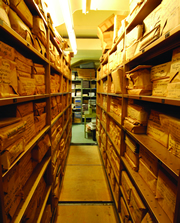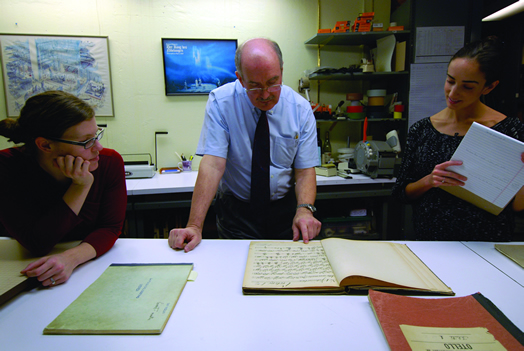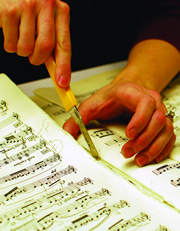Allegro
A visit to the Met music library
Volume 114, No. 6June, 2014
 There is always more going on at the Metropolitan Opera House than meets the eye: wig fittings, dance rehearsals, orchestral rehearsals. One particularly busy corner of the Met can be found by descending two stories below the stage level to the music library. I recently visited the library and spoke with Chief Librarian Robert Sutherland and Assistant Librarian Melissa Robason.
There is always more going on at the Metropolitan Opera House than meets the eye: wig fittings, dance rehearsals, orchestral rehearsals. One particularly busy corner of the Met can be found by descending two stories below the stage level to the music library. I recently visited the library and spoke with Chief Librarian Robert Sutherland and Assistant Librarian Melissa Robason.
During a typical season at the Metropolitan Opera House, between 25 and 29 operas are performed. For each of these operas, there may be anywhere from 37 to 98 players in the orchestra pit, as well as the conductor, the chorus onstage, and the principals and soloists. Add to that an army of music staff who assist in preparing each production – rehearsal pianists, assistant conductors, and prompters – and you can imagine the enormous number of musical scores and parts that are in use at any given moment.
These scores and parts are the responsibility of the four full-time librarians of the Metropolitan Opera: Chief Librarian Robert Sutherland and Assistant Librarians Jennifer Johnson, Àngels Martinez, and Melissa Robason. They juggle a multitude of duties to ensure that the Met can run seamlessly. On a daily basis, the librarians prepare and distribute orchestral parts for each rehearsal and performance, collect and count parts after every service, distribute stage band parts, mark changes such as cuts and transpositions, and prepare chorus parts. In addition, they must also repair damaged parts, produce new parts, graph the orchestral setup of the rehearsal room and pit for each production, coordinate with conductors and directors to determine which editions will be used for future productions, and prepare orchestral audition material.
A TYPICAL DAY AT THE MET
When I ask Assistant Librarian Melissa Robason to describe a typical day at the Met, she laughs and replies, “I don’t think you can say there’s a ‘typical’ day, because every day is different and changing.” Chief Librarian Robert Sutherland adds, “The only thing that’s typical about any given day is that usually the day is clobbered by about 9:45 a.m. Then we are just simply trying to stay alive and cover all the bases until about 3, at which point we tend to focus on what we really need to do, which is getting things ready for tonight, tomorrow, next week, next month, next season, the season after.”
On any given day during the season, the primary responsibility of the librarians is whatever rehearsal or performance is going on at that moment. Because there are often as many as three or four rehearsals taking place concurrently (orchestra, chorus, and piano rehearsals, for example), it can be a challenge to juggle these duties with the preparation for future rehearsals and performances. Add to this the fact that there are often last-minute changes in opera (such as cuts or transpositions because a singer is ill and is being replaced by another singer), and it is clear that flexibility and the capacity to think on one’s feet are essential to the job. “It’s like trying to run on loose gravel,” says Sutherland. “You can’t trust where you’re going to land, and you might have to shift very quickly.”
Over the summer, when rehearsals and performances are not taking place, the librarians are able to focus their energies on preparing parts for the next season and repairing damaged parts.

Melissa Robason, Robert Sutherland and Sarah Vonsattel study a historic violin part of Wagner’s “Rienzi.”
PREPARATION OF PARTS
The Met’s librarians are constantly busy producing and preparing new material for future productions. The preparation of new material for a single opera can take in excess of 100 work hours. (There are on average 32 string parts for an opera, and each of these takes up to 3.5 hours to bow, totaling 96 to 112 hours. This does not even include the time it takes to create and prepare the wind and brass parts.) For many operas, the Met librarians create their own materials for use in performance. “Enchanted Island,” a baroque pasticcio that premiered in the 2011-2012 season and returned this season, is an example of a production for which everything was produced in-house. Another example of work produced in-house is the new set of parts for Donizetti’s “L’Elisir d’Amore,” which replaced an ancient and difficult-to-read set.
A HISTORY IN PARTS
In addition to preparing new parts, the librarians work to keep existing parts in usable condition. Given the remarkable age and history of much of the Met’s music collection, this is a craft unto itself. I enjoyed watching Melissa Robason repair a concertmaster part for Strauss’ “Arabella,” which is currently being performed at the Met. In order to repair pages that have fallen out of the part, she first takes off the covers and cuts the old sewing. Next, she takes apart each “signature,” or section of pages, and carefully removes old tape using a small knife. She goes through each page to repair and reinforce it with Filmoplast, an acid-free tape, and then rebuilds each signature. Finally, she hand-sews each signature back into the cover and uses cloth tape to reinforce the binding. Hand-sewing is used rather than staples because staples rust over time, and they tear bigger holes in the music. Sewing also helps the music to lie flat more effectively than staples, and the stitches “move with the part,” explains Melissa. This is labor-intensive work, and the process of repairing a single part in this way, can take two to three hours.
In spite of this careful repair and restoration of parts, very old sets of parts will eventually need to be replaced. Even when a set of parts is “retired” due to its age and replaced with a new set, some players choose to continue using the old parts because that is what they are used to. Robert Sutherland recounts the story of former orchestra members who continued using the old “La Bohème” parts long after they had been replaced. The old parts were printed in manuscript and the notes were blue. To the typical eye, they may have appeared illegible, but performers who were used to them preferred them, even as newer members of the orchestra preferred the new parts. It was the case, says Sutherland, of “I know what I like, I like what I know.”
One particularly amusing anecdote about a very old set of parts concerns the old parts to Verdi’s “Otello.” I was shown a first edition “Otello” violin part that was in use until 1993. This set of parts was from the 1888-1889 season at the Met. (Verdi’s “Otello” was premiered in 1887.) The imprint of the hand press is visible on the cotton rag paper. Remarkably, the part is still in very good condition, a tribute both to acid-free paper and to the care with which these parts were repaired and maintained by the previous Met librarians. In 1993, a weary violist set some things on top of his car after finishing a performance, including the fourth-stand viola part of “Otello.” He took some things off the top of the car before driving home, but not, it would seem, the “Otello” part, and that is the last that was seen of it. This event prompted Sutherland to strongly recommend the creation of a new set of “Otello” parts for use in the pit, out of respect for the historical significance of some of the very old parts in the Met library’s collection.
Another historic set of parts in the library is that of Wagner’s “Rienzi.” Written between 1838 and 1840, “Rienzi” premiered at the Met on Feb. 5, 1886. Robert Sutherland showed me a part stamped with the copyright “1884, Berlin.” The overture of these parts was engraved, but the rest of the opera was hand-copied on manuscript, so no two parts are the same. At that time, it would not have made economic sense to pay for plate engraving of the entire set, so instead, copyists were hired to hand-copy the entire opera – every single part, every single stand. Looking through the parts, one can recognize the different hands of the many different copyists, and I was struck not only by the excellent condition of the parts but also by the beauty of the handwriting.
Sometimes, comments written in the parts by the players offer interesting insights into historical events. On March 4, 1960, the American baritone Leonard Warren suffered a heart attack and died on stage during a performance of Verdi’s “La Forza del Destino” at the Met. While stage managers and other eyewitnesses gave differing accounts of when he died, the answer to this mystery may be written in the concertmaster’s part where, after a cadence, a musician wrote, “Warren dropped dead here.” These parts were in use until the 1994-1995 season.

Melissa Robason repairs a page of Strauss’ “Arabella.”
WHO BECOMES A MUSIC LIBRARIAN?
The four librarians of the Met have varied backgrounds, but they all share a passion for music and a history as instrumentalists themselves: Robert Sutherland as a trumpet player, Melissa Robason as an oboist, Jennifer Johnson as a trombonist, and Àngels Martinez as a pianist.
When asked, “What kind of person becomes a music librarian?” Melissa Robason emphasizes an attention to detail. Both Melissa and Robert Sutherland agree that an understanding of what it’s like to be a performer is very important. This enables them to appreciate the pressures on performers and the importance of parts that are easily comprehensible: not too much or too little white space, clearly marked bowings, transpositions, and cuts, and high-quality printing. Sutherland also cites “boundless curiosity and imagination” as important prerequisites for an orchestra librarian.
Interestingly enough, there is no degree program to become a music librarian; it is a skill that is learned by doing, in the old style of the apprentice system. Every music library has its own habits and peculiarities, and the best way to learn is on the job.
A recent job opening attracted over 50 applicants. Approximately 20 of these applicants were advanced and invited to the Met to audition. Before arriving at the Met, the finalists were asked to submit a written statement and examples of hand-copying and computer-copying of music. Once they arrived, they were given a written test designed to provide information about their musical knowledge and problem-solving abilities. The test included hand-copying, questions testing basic musical knowledge, and questions regarding differences in versions and editions of specific operas. Candidates were then interviewed, and those chosen were given a trial week.
Although the demands on the Met’s librarians are immense, the performers onstage and in the pit tend to get the most attention from the audience. The behind-the-scenes work of the librarians is what makes it possible for the Met’s performances to run smoothly night in, night out, and because they do their job so well, they often go unnoticed. For this reason, says Sutherland, “The work itself must be the reward.” It is a shared love of music, and of opera in particular, that inspires the four librarians of the Met to maintain their standard of excellence. As Melissa Robason puts it, the most rewarding part of the job is “the knowledge that you are contributing to this great work of art.”
Sarah Vonsattel is a second violinist in the Met orchestra. This article first appeared at www.METOrchestraMusicians.org.
